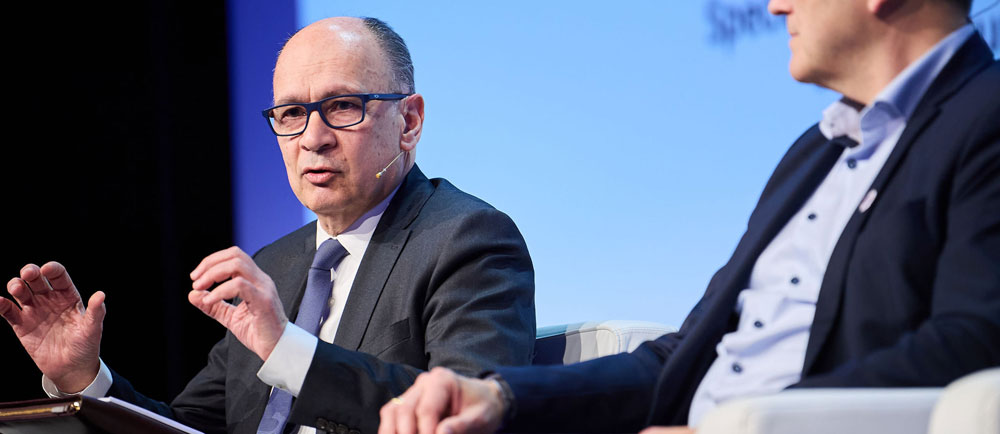2025 Annual Conference – Inspirational Talk and Session 3
Tuesday, Apr 15, 2025
Putting climate and nature on the balance sheet
Setting the scene for the afternoon sessions, Tobias Bandel, Co-founder, The Landbanking Group and Cherry Muijsson, Chief Investment Officer, Multi-Asset Strategies and Solutions, BlackRock, described how to de-risk investment and put natural capital at the forefront.
During the second inspirational talk of the day, Mr Bandel pointed to the change in business cases now that nature no longer provides the reliable and free services it once did. His group has developed a natural capital management platform that measures, manages and monetises these investments into assets which are identifiable, controllable and generate future economic value.
As investors, BlackRock looks at nature from the twin perspectives of quantifying risk and identifying investment opportunities. Ms Muijsson estimated the market for nature-positive business models to be around $10 trillion, half of which is linked to sustainable food, agriculture and land use. As an investor, BlackRock assesses companies according to their resource efficiency, circular business models, nature restoration and wider natural use.
Summing up, Mr Bandel said: “Let’s put nature on the balance sheet. Financing the transition towards more sustainable land use is an interesting investment opportunity.”
On behalf of The Landbanking Group, Tobias Bandel signed an agreement at this year’s Annual Conference to join the Forum as a supporting partner.
Session 3: Implementing the transition – what will make the difference
Harald Grethe, Director, Agora Agrar and Professor Head of Agricultural Development and Trade Group, Humboldt-University of Berlin, began the panel discussion by pointing to the imperative of reconciling competitiveness and sustainability. Public money should be used to create markets private capital ignores. “Not wheat or beef, but things like biodiversity or carbon sequestration.” He championed a strong CAP budget, not on grounds of farmers’ “neediness” or income support, but as a reward for providing what society wants. To measure those goods, satellite imagery could be used to identify factors such as carbon content.
Professor Grethe urged policymakers to promote sustainable consumption and to develop additional funding opportunities, notably the inclusion of agriculture in the emissions trading scheme to reward good practice. The agricultural community should be less hesitant and become more involved in climate discussions on greenhouse gas pricing.
Katie McRobert, CEO, Australian Farm Institute, emphasised the importance of establishing common ground. This encompasses “the shared values that people working with agriculture hold with other people in society”. In a post-truth world of mistrust and polarisation, she warned: “Until we articulate and identify those shared values, we will be stuck”. Her organisation has produced an Australian Agricultural Sustainability Framework with principles enshrining shared environmental, social and financial values for agriculture. The exercise was far from easy. But the result is “a set of shared principles, at least for Australia, which we think are transferable to other people as well as other systems”. Time may be short, but the abundance of intellectual capital and goodwill available should be leveraged to define shared values and apply Mike Massimino’s advice of focussing on the mission.
Grzegorz Brodziak, Farmer & CEO Goodvalley, Poland and President of the Management Board, Polska Federacja Rolna, identified a level playing field, regulations which do not restrict, but help to establish and run, a sustainable business profitably as key factors for a successful transition. He spoke from the experience of turning old state-run Polish operations into 25 thriving pig farms with a sustainable green value chain. The company has considerably reduced the CO2 footprint of its final product, pork. Goodvalley calculates its own carbon footprint and life cycle assessments to demonstrate its green credentials to consumers. He emphasised the need “to re-educate consumers and the general public about what agriculture is about”. Livestock is an essential part of agriculture. “The poop is part of the loop and without livestock production, we cannot have sustainable models.”
Tassos Haniotis, Special Advisor for Sustainable Productivity, Forum for the Future of Agriculture and Senior Guest Research Scholar, IIASA, described the big picture as focussing on sustainable productivity “because we need to avoid the mistakes of the past where we increased the overall level of production at the cost of the environment”. The new policy design must combine economic and environmental factors into “a single sustainable productivity payment” conditional on performance.
He welcomed recognition in the European Commission’s recent Vision for Agriculture and Food that primary agriculture is a strategic sector contributing to society. However, this fails to set clear priorities. Solid analysis and impact assessments are essential. There must be “clear options that you are able to quantify the impacts”. When reforms are introduced, it is not their initial speed that is crucial, but that their path is irreversible.






